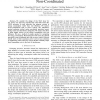Free Online Productivity Tools
i2Speak
i2Symbol
i2OCR
iTex2Img
iWeb2Print
iWeb2Shot
i2Type
iPdf2Split
iPdf2Merge
i2Bopomofo
i2Arabic
i2Style
i2Image
i2PDF
iLatex2Rtf
Sci2ools
ISCAS
2006
IEEE
2006
IEEE
The optimal MAC layer for low-power UWB is non-coordinated
— We consider the design of the MAC layer for low power, low data-rate, impulse-radio ultra-wide band (IRUWB) networks. In such networks, the primary concern is energy consumption rather than rate efficiency. We explore several dimensions such as power control, rate adaptation, mutual exclusion, slotted versus non-slotted operation, power saving modes and interference mitigation. We analyze the effect of these design choices on the energy consumption and rate efficiency. We use a method of energy quanta for computing the energy consumption. We find that for both cases, the optimal operation is non-coordinated and with no power control. Sources should send at their maximum power and not pay attention to neighboring nodes. However, sources should constantly adapt their transmission rate to the level of interference.
| Added | 12 Jun 2010 |
| Updated | 12 Jun 2010 |
| Type | Conference |
| Year | 2006 |
| Where | ISCAS |
| Authors | Ruben Merz, Alaeddine El Fawal, Jean-Yves Le Boudec, Bozidar Radunovic, Jörg Widmer |
Comments (0)

